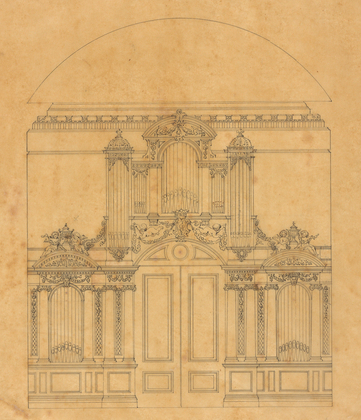
Gerald FitzGerald
Design for an organ case, Carton, Co. Kildare
1857
81/52
The architectural history of Carton is long and involved. The first house on the site was built in 1603 by William Talbot, who had leased the lands from Gerald FitzGerald, 14th Earl of Kildare. This house was greatly extended in the latter half of the seventeenth century by Robert Talbot, Duke of Tyrconnell. In 1739 Robert FitzGerald, 19th Earl of Kildare, repurchased the lease on Carton and employed architect Richard Castle to remodel and extend the existing house. In 1762 the 20th Earl asked Isaac Ware to remodel Carton. Ware’s proposals were unexecuted, as were schemes prepared in 1776 by James Wyatt and 1813 by Francis Johnston. It was left to Sir Richard Morrison to give the house its current external appearance c. 1815 for Augustus FitzGerald, 3rd Duke of Leinster.
Internally, the finest room in the house was, and remains, Richard Castle’s double-height Saloon. Featuring plasterwork by Paolo and Filippo Lafranchini, the Saloon has rightly been recognised as ‘a high point of figurative stuccowork in Ireland’. Into the north end of this space a large Baroque organ case was inserted in 1857 to this design by Lord Gerald FitzGerald, the 3rd Duke’s second son. Aside from the Carton organ, Gerald’s musical interests found other outlets. He was a member, and for a time president, of the Wandering Minstrels, an amateur orchestra of forty or so players drawn from the ranks of the aristocracy and military. In their heyday, the Wandering Minstrels filled the best concert halls in London, giving performances mainly, but not exclusively, for charity.